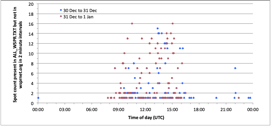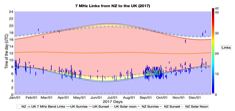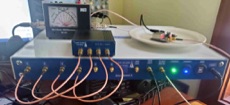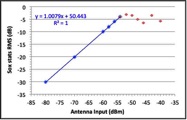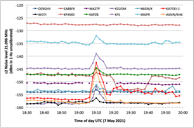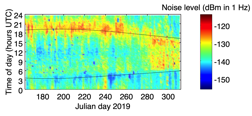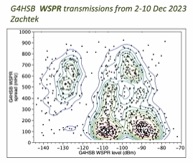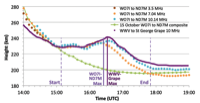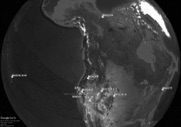Technical reports and articles that present methods, applications and results connected with WsprDaemon
There is much information on WsprDaemon on the KiwiSDR Discussion Forum
WSPR, wsprdaemon, kiwirecorder and a separate topic on
wsprdaemon noise graphs and of course our own WsprDaemon Forum.
Clint Turner, KA7OEI, who uses WsprDaemon with several KiwiSDRs at the Northern Utah SDR site, has an informative and practical blog post on calibrating the signal and noise measurements and setting the correct values into the wsprdaemon.conf file.
Simplified diagram of the WsprDaemon database architecture and its relationship to wsprnet
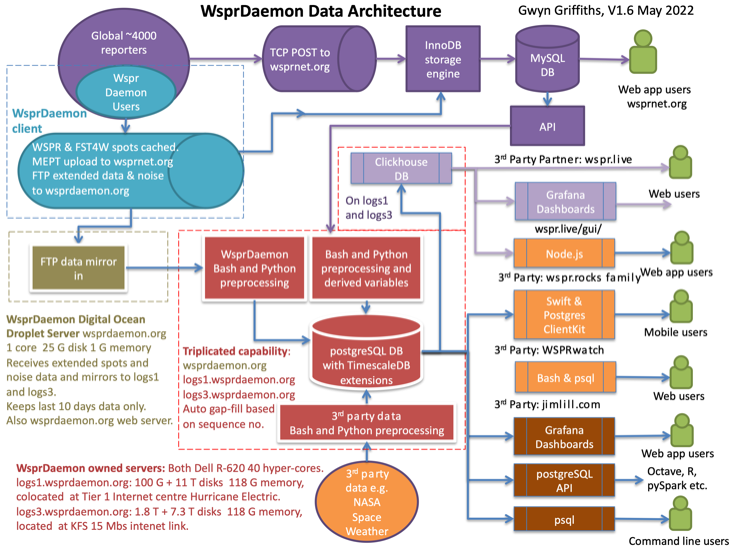
Gwyn Griffiths, with contributions from Rob Robinett and Phil Barnard "Success rates of uploads to wsprnet.org". A detailed study that shows that WsprDaemon has a 100% success rate in spot upload but that when using WSJT-X it depends on the processing power of, and processing load on, the computer and can vary from 88% to 99.9%.
Lo, S., N. Rankov, C. Mitchell, B.A. Witvliet, T. P. Jayawardena, G. Bust, W. Liles, and G. Griffiths. 2022. "A Systematic Study of 7 MHz Greyline Propagation Using Amateur Radio Beacon Signals", Atmosphere 13, no. 8: 1340. https://doi.org/10.3390/atmos13081340. This paper investigates 7 MHz ionospheric propagation between pairs of distant countries that simultaneously lie on the terminator. Drawing on local noise observations from WsprDaemon the observed asymmetry in reception pattern could be due to the increased electromagnetic noise across Europe summer afternoons/evenings from thunderstorms.
Erwin Serlé. 2023. "FST4W als Ausbreitungstool für die KW-Bänder", Funk Amateur, 8: 612-616. This is a translation into German by Erwin, PE3ES, of a presentation and paper given by Gwyn Griffiths G3ZIL in September 2022 at the TAPR/ARRL Digital Communications Conference. A pdf of the August 2023 issue of the magazine is available for reading online.
Gwyn Griffiths. 2023. "Response to an Ionospheric Perturbation at HF: Results from Simultaneous Six-Band WB6CXC 'Beacon Blaster-6' FST4W Transmissions during the 11 July 2023 R2 Blackout over N. America". An informal report on a useful test on how the simultaneous transmissions on 80, 40, 30, 20, 15 and 10 m, at 100% duty cycle, enabled an excellent delineation of the excess absorption during this Blackout. This is a useful validation of the transmitter from Turn Island Systems ahead of the HamSci Festival of Eclipse Science in October 2023 and April 2024.
Gwyn Griffiths, Rob Robinett and Glenn Elmore "Estimating LF-HF band noise while acquiring WSPR spots". Experiment findings documenting our investigations into RMS and FFT noise estimation methods and their use in WsprDaemon with KiwiSDRs. Unpublished report on ResearchGate.net, 2019.
Glenn Elmore, N6GN "Notes on Improving Station Noise Performance". Updated Version 0.6 19 March 2025. Noise reduction can become a quantifiable RF engineering problem with lots of pieces to keep track of. But the results have shown themselves to be achievable and very worthwhile. The WSPR database and tools help greatly toward this.
Gwyn Griffiths, G3ZIL "M3.9 Solar Flare Radio Noise Observed using KiwiSDRs and WsprDaemon Noise Estimates". This one-page note shows how the noise level recorded by WsprDaemon at several KiwiSDR sites rose in response to a Solar Noise Burst from the M3.9 Solar Flare around 1911 UTC on 7 May 2021. These results were for 21 MHz WSPR band. Sites with local noise typical of residential areas saw a small increase or none at all.
Gwyn Griffiths, Rob Robinett and Glenn Elmore "Estimating LF-HF band noise while acquiring WSPR spots". Article Used with permission, September/October 2020 QEX; copyright ARRL. Summary of methods within WsprDaemon and examples of noise observations.
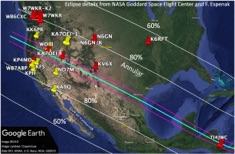
Gwyn Griffiths, on behalf of the WsprDaemon community. 2023. As a contribution to the HamSci Festival of Eclipse Science specific measurements using FST4W were made during the 14 October 2023 eclipse. Several stations (red map pins) used Turn Island Systems multi-band BB-6 for simultaneous transmissions every two minutes. Most receivers (yellow map pins) used multiband KiwiSDR or RX888 with KA9Q Radio, with reporting via WsprDaemon. Many systems used GPSDOs for stable and accurate frequency control.
A series of one-page summaries of early results is available here:
Part 0 - An Introduction.
Part 1 - D region anomalies in noise and signals.
Part 2 - Effects of reduction in F2 critical frequency.
Part 3 - Frequency spread - showing change to one-hop during eclipse.
Part 4 - Multiband Doppler shift and path velocity.
Part 5 - Temporary transition from one-hop to two-hop sidescatter
Part 6 - Comparison of FST4W and Grape Doppler shift observations
Part 7 - Tracking height of the 'F2 layer' via FST4W Doppler shift

Technical
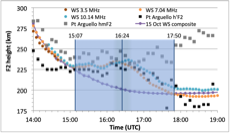
Ryan Tolboom N2BP has written a deconstruction and explanation of the code used within WSJT-X to compute frequency spread in FST4W. Subsequently, he showed how frequency spread could be measured with WSPR. His Python code to process WSPR wav files and output frequency spread has been implemented by Rob Robinett in WsprDaemon v3.1.3 onward. This short study compared frequeny spread measured by WSPR spots from a selection of UK transmitters received by OE9GHV in December 2023. Gwyn Griffiths.
Gwyn Griffiths. Combining FST4W frequency spread measurement and WsprDaemon's 0.1 Hz resolution frequency reporting with GPSDO transmitters and receivers enables useful observations of sporadic E (Es) at HF. This note describes observations at 14 MHz on the 906 km path from G3ZIL (IO90hw, QRP Labs QDX tx) to OE9GHV (JN47wk, four KiwiSDRs) on 26-27 December 2023.
Gwyn Griffiths. The 31 December 2023 X5.0 solar flare was the largest since September 2017. Its extreme UV radiation resulted in excess absorption at HF over North America. This one-page note shows excess absorption reduced propagated-in noise at KA7OEI-1 on 40-15 m while a Solar Radio Burst was seen on 12 m and 10 m.
Gwyn Griffiths. Now that WsprDaemon has the capability of acquiring Doppler shift of standard frequency stations such as WWV and CHU from RX888 Mk II receivers and reporting results to the HamSci Personal Space Weather Station database this Guide may be of help for interpreting the propagation features seen in the spectrograms.
Gwyn Griffiths. "Measuring height of reflection at HF". Article in RSGB RadCom, 100(8): 42-44. August 2024. Reproduced with the kind permission of the RSGB.
Gwyn Griffiths. "The October 2023 annular eclipse: some effects on HF propagation" Article in RSGB RadCom, 100(7): 40-42, July 2024. Reproduced with the kind permission of the RSGB.
Gwyn Griffiths. "Identifying 14 MHz propagation modes using FST4W SNR and spectral spread" Article in ARRL QEX May/June 2024. Reproduced with the kind permission of the ARRL.
WsprDaemon
Robust decoding and reporting for WSPR FST4W FT8 FT4 WWV WWVH CHU
Gwyn Griffiths. "April 2024 eclipse: The effect on transatlantic HF propagation". Article in RSGB RadCom, 100(12): 36-38. December 2024. Reproduced with the kind permission of the RSGB.
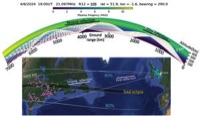
Barry Johnson W4WB and Gene Marcus W3PM. "A Modest Study of WSPR-2 Spectral Width". In this careful study of spectral width measurements using WSPR, enabled by the modified wsprd decoder by Ryan Tolboom, Barry and Gene explore, among others, the effects of using TCXO vs GPSDO, frequency of the GPSDO, effect of frequency hopping, SNR and transmission frequency.


